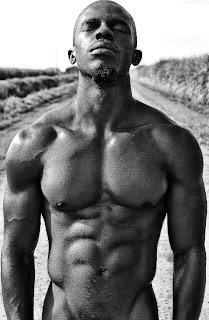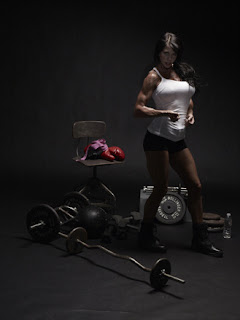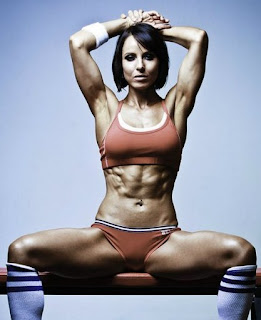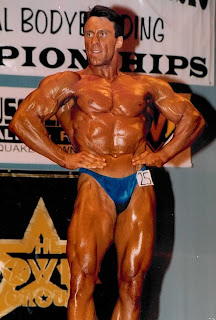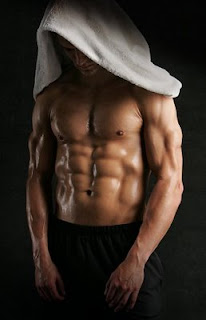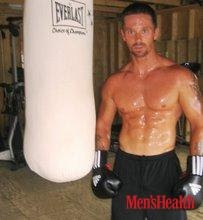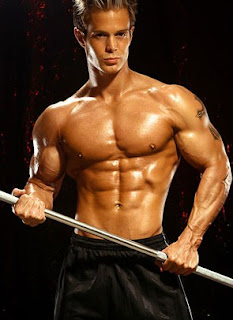
Whatever your doing must not be working. Why else would you be reading this?
You swapped fried chicken for grilled and your treadmill is finally getting more attention than your TiVo. But your body isn’t quite where you want it to be. Don’t worry: Your bag of fat-burning tricks isn’t empty yet. We’ve collected 50 comprehensive tips, all backed by more science than a NASA shuttle launch. By the time you’ve incorporated these fat-burning gems, we’ll have 50 more for you. But by then, you probably won’t need them.
What You Eat
Getting lean obviously relies heavily on a solid nutrition plan. So it should come as no surprise that what and how you eat can have a big impact on your success. Use these 11 food rules to amp up your fat-burning potential.
1. Go Pro
A high-protein diet not only promotes hypertrophy but also enhances fat loss. Researchers at Skidmore College (Saratoga Springs, New York) found that when subjects followed a high-protein diet–40% of total daily calories from protein–for eight weeks, they lost significantly more bodyfat, particularly abdominal fat, than those following a low-fat/high-carb diet. One reason eating more protein may work is that it boosts levels of peptide YY, a hormone produced by gut cells that travels to the brain to decrease hunger and increase satiety.
2. Slow Down
When you reach for carbs, choose slow-digesting whole grains such as brown rice, oatmeal and whole-wheat bread, which keep insulin levels low and steady, and prevent insulin spikes from halting fat-burning and ramping up fat-storing.
A study conducted by researchers at Pennsylvania State University (University Park) found that subjects following a low-calorie diet with carbs coming only from whole grains lost significantly more abdominal fat than those following a low-calorie diet with carbs from refined sources.
3. Get Fat
Not only will certain fats–particularly omega-3s –not lead to fat gain, but they can actually promote fat loss. Eating fat to lose fat seems counterintuitive, but if you keep your fat intake at about 30% of your total daily calories by choosing fatty fish such as salmon, sardines or trout as well as other healthy fat sources such as olive oil, peanut butter and walnuts, you can actually boost your fat loss compared to eating a low-fat diet.
4. Egg You On
Eggs are packed with protein and have been shown to promote muscle strength and mass, and research shows that subjects consuming eggs for breakfast not only eat fewer calories throughout the day but also lose significantly more bodyfat. We recommend eating eggs for breakfast daily, scrambling three whole eggs with three egg whites.
5. Unforbidden Fruit
A study from the Scripps Clinic (San Diego) reported that subjects eating half a grapefruit or drinking 8 ounces of grapefruit juice three times a day while otherwise eating normally lost an average of 4 pounds in 12 weeks, with some test subjects losing more than 10 pounds without dieting. The researchers suggest the effect is likely due to grapefruit’s ability to reduce insulin levels. Try adding half a grapefruit to a few of your meals such as breakfast, lunch and preworkout.
6. Milk It
Dairy products are rich in calcium, which can help spur fat loss, particularly around your abs. This may be due to the fact that calcium regulates the hormone calcitriol, which causes the body to produce fat and inhibit fat-burning. When calcium levels are adequate, calcitriol and fat production are suppressed while fat-burning is enhanced. Adding low-fat versions of cottage cheese, milk and yogurt (Greek or plain) to your diet are great ways to boost protein intake and aid fat loss.
7. An Apple A Day
Apples are a great slow-digesting carb that contain numerous beneficial antioxidants. One group of compounds known as apple polyphenols has been found to boost muscle strength, endurance and even fat loss, especially from around the abs. While apple polyphenols appear to directly decrease bodyfat by increasing the activity of genes that enhance fat-burning and decrease fat production and storage, the boost in endurance and strength can help further fat loss by allowing you to train harder longer.
A typical large apple provides about 200 mg of apple polyphenols and about 30 grams of carbs.
8. Spice It Up
Hot peppers contain the active ingredient capsaicin, a chemical that has been shown to promote calorie-burning at rest as well as reduce hunger and food intake. Its effects are particularly enhanced when used with caffeine, and research also shows that it boosts fat-burning during exercise. Try adding crushed red pepper, hot peppers or hot pepper sauce to your meals to burn extra calories and fat. If you can’t stand the heat, try supplements that contain capsaicin.
9. Go Nuts
A study from Loma Linda University (California) reported that subjects following a low-calorie, higher-fat diet (40% of total calories from fat) with the majority of fat coming from almonds lost significantly more bodyfat and fat around the abs in 24 weeks than subjects consuming the same calories but more carbs and less fat. So be sure to include nuts such as almonds, Brazil nuts, macadamia nuts and walnuts in your diet.
10. Be Multi-Organic
Sure, it’s pricier, but organic beef and dairy are worth the extra bucks. UK scientists found that organic milk had about 70% more omega-3 fatty acids than conventional milk, and a study published in the Journal of Dairy Science found that grass-fed cows produced milk containing 500% more conjugated linoleic acid [CLA) than cows who ate grain. Meat from organically raised cattle also contains higher levels of CLA and omega-3 fats. Since omega-3s and CLA can help you drop fat as well as gain muscle, it makes sense to shell out the extra cash for organic cheese, cottage cheese, milk and yogurt as well as grass-fed beef.
11. Add Some GUAC
Avocados are full of monounsaturated fat, which isn’t generally stored as bodyfat. They also contain mannoheptulose, a sugar that actually blunts insulin release and enhances calcium absorption.
As mentioned earlier, keeping insulin low at most times of day is critical for encouraging fat loss, and getting adequate calcium can also promote fat loss. Try adding a quarter of an avocado to salads and sandwiches.
What You Drink
Beverages can play an important role in your ability to drop fat. Consider sipping or passing on these eight beverages to get extra-lean.
12. Go Green
The main ingredient in green tea, epigallocatechin gallate (EGCG), inhibits the enzyme that normally breaks down the neurohormone norepinephrine. Norepinephrine keeps the metabolic rate up, so preventing its breakdown helps you burn more calories throughout the day. Drinking green tea is a great way to stay hydrated during workouts, as a new study in The Journal of Nutrition reported that subjects drinking green tea and exercising lost significantly more abdominal fat than those drinking a placebo.
13. In The Black
Green and black teas all come from the same plant, but different processing causes black and oolong teas to lose their green color and turn brownish/black. Oolong tea has been shown to enhance metabolic rate due to polyphenols other than EGCG. Black tea may also aid fat loss: Researchers from University College London reported that black tea consumption can help reduce Cortisol levels, which encourages fat storage especially around the midsection.
14. Be Aqua Man
German researchers have shown that drinking about 2 cups of cold water can temporarily boost metabolic rate by roughly 30%. The effect appears to be mainly due to an increase in norepinephrine.
15. Get Energized
Certain energy drinks have been shown to boost fat loss. University of Oklahoma (Norman) researchers reported in a 2008 study that when 60 male and female subjects consumed a diet energy drink containing 200 mg of caffeine and 250 mg of EGCG from green tea extract for 28 days, they lost more than 1 pound of bodyfat without changing their diets or exercise habits.
16. Whey Lean
Drinking whey protein as a between-meals snack is a smart way to enhance not only muscle growth but also fat loss. UK researchers found that when subjects consumed a whey protein shake 90 minutes before eating a buffet-style meal, they ate significantly less food than when they consumed a casein shake beforehand. The scientists reported that this was due to whey’s ability to boost levels of the hunger-blunting hormones cholecystokinin and glucagonlike peptide-I.
17. Say Soy-Anara To Fat
Soy protein is a proven fat-burner. In fact, in a 2008 review paper University of Alabama at Birmingham researchers concluded that soy protein can aid fat loss, possibly by decreasing appetite and calorie intake. The scientists also found that subjects drinking 20 grams of soy daily for three months lost a significant amount of abdominal fat.
18. Get Thick
When you whip up a protein shake, consider making it thicker by using less water. It could help you feel less hungry while dieting. In a study from Purdue University (West Lafayette, Indiana), subjects drank two shakes that were identical in nutritional content, and reported significantly greater and more prolonged reductions in hunger after drinking the thicker shake.
19. Not So Sweet
Even though artificially sweetened drinks are calorie-free, drinking too many can actually hinder your fat-loss progress. It seems that beverages like diet soda mess with your brain’s ability to regulate calorie intake, causing you to feel hungrier than normal so you eat more total calories.
Other research suggests that the sweet taste of these drinks can increase the release of insulin, which can blunt fat-burning and enhance fat storage.
What Supplements You Take
While whole foods are the key element to getting lean, supplements can provide a potent fat-burning stimulus. Consider using these six supps.
20. Go Even Greener
The majority of studies showing the effectiveness of green tea for fat loss have used green tea extract. One study confirmed that the EGCG from the extract was absorbed significantly better than the EGCG from the tea. Take about 500 mg of green tea extract in the morning and afternoon before meals.
21. See CLA
You’ll also want to add the healthy fat CLA to your supplement regimen. CLA can significantly aid fat loss while simultaneously enhancing hypertrophy and strength gains. Research shows it can even help specifically target ab fat.
22. Go Fish
As mentioned in tip No. 3, the essential omega-3 fats in fish oil promote fat loss, which is enhanced with exercise. This is also true for fish-oil supplements containing omega-3 fats. Take 1-2 grams of fish oil at breakfast, lunch and dinner.
23. You Bet Your Astaxanthin
Japanese researchers reported in a 2008 study that mice supplemented with astaxanthin combined with an exercise program for four weeks saw accelerated fat-burning, greater fat loss and enhanced endurance compared to mice that just exercised. The scientists determined that astaxanthin protects the system that transports fat into the mitochondria of muscle cells where it’s burned as fuel. Take 4 mg of astaxanthin with food once or twice per day, with one dose taken with your preworkout meal.
24. Go Commercial
A 2009 study reported that lifters taking the fat-burner Meltdown by VPX (containing caffeine, synephrine, yohimbine and beta-phenylethyl-amine, to name a few) burned 30% more calories and had a more than 40% increase in markers of lipolysis (fat release from fat cells) for the 90 minutes afterward when researchers measured calorie burn compared to when subjects consumed a placebo. Regardless of the brand of thermogenic you choose, follow label instructions and take the other five supplements mentioned here as well.
How You Lift
The way you weight-train can have a huge effect on how much fat you burn. Consider these eight rules when hitting the iron.
25. Carry More Fat Away With Carnitine
This amino-acidlike compound is critical for carrying fat in the body to the mitochondria of cells, where it’s burned away for good. Research confirms that taking carnitine when dieting can help maximize fat-burning efforts. Take 1-2 grams of carnitine in the form of L-carnitine, L-carnitine L-tartrate or glycine propionyl-L-carnitine.
26. Go Heavy
Excess post-exercise oxygen consumption refers to the increased metabolic rate you enjoy after a workout. Scien- tists at the Norwegian University of Sport and Physical Education (Oslo) analyzed multiple studies and found that training with heavier weights for fewer reps produces a greater rise in resting metabolic rate that’ll last longer compared to training with lighter weights and doing more reps. Although most guys may think they need to train with higher reps to burn more fat, you still want to lift heavy (3-7 reps) some of the time to maximize the calories and fat you burn when you’re not at the gym.
27. Go Light
While lifting heavy does burn more calories post- workout, performing higher reps burns more calories during the workout, as College of New Jersey (Ewing) researchers reported at a 2007 annual meeting of the National Strength and Conditioning Association.(51) Be sure to mix up your training by using lighter weight and higher reps (10-20) during some workouts and heavy weight and low reps (3-7) in others. Another way to get the best of both worlds is to perform four sets of most exercises, doing your first two sets with heavy weight and low reps and the last two with light weight and high reps.
28. Rest Less
Researchers from the College of New Jersey (Ewing) also discovered that when subjects rested 30 seconds between sets on the bench press, they burned just more than 50% more calories than when they rested three minutes.
To maximize fat toss, keep your workout moving by resting less than a minute between sets.
29. Force It
A study on collegiate football players found that using a high-intensity weight program–just one set per exercise for 6-10 reps to failure, plus forced reps and a static contraction for several seconds–caused more bodyfat loss in 10 weeks than a lower-intensity program consisting of three sets of 6-10 reps per exercise taken just to muscle failure. This could be due to a greater hike in growth hormone (GH) in the high-intensity group: In a study from Finland, forced reps boosted GH three times higher than training to failure. Go past failure when trying to get lean by using forced reps, static contractions, rest-pause or drop sets.
30. Be Free
Using free weights, especially in multijoint moves such as the squat, has been found to burn more calories than doing similar exercises on machines like the leg press. Scientists said the difference may be due to the greater number of stabilizer muscles used during multijoint exercises done with free weights.
31. Feel The Need For Speed
Fast, explosive reps burn more calories than the typical slow, controlled reps you’re used to doing in the gym, say researchers from Ball State University (Muncie, Indiana). They believe that because fast-twitch muscle fibers are less energy-efficient than their slow-twitch counterparts, they burn more fuel during exercise. To perform fast reps in your workouts, choose a weight equal to 30`% of your one-rep max (or a weight you can lift for 15-35 reps) for each exercise. Do your first two sets with 3-8 fast reps, then follow with 2-3 sets of normal-paced reps.
32. Be Negative
In one recent study, subjects who performed a negative-rep workout of three sets of the bench press and squat increased their GH levels by almost 4,000%. Since GH frees up fat from fat cells, using negative reps may help you shed extra bodyfat. To add negatives to your routine, either have a spotter help you get 3-5 negative reps after reaching failure on a regular set, or load the bar with about 120% of your one-rep max and have a spotter help you perform five negative reps that take you 3-5 seconds each to complete.
33. Tune In
Listening to your iPod can boost your workout intensity and fat-loss efforts. A study conducted by the Weider Research Group and presented at the 2008 annual meeting of the National Strength and Conditioning Association found that trained subjects listening to their own music selection could complete significantly more reps than when they trained without their preferred music.
How You Run
Cardio, obviously, is a primary component of getting lean. It’s the easiest way to burn the most calories during exercise. Use these rules to help you maximize your fat loss.
34. Go After It
Do your cardio after you hit the weights. Japanese researchers found that when subjects performed cardio after resistance training, they burned significantly more fat than when they did cardio first. The scientists also reported that fat-burning was maximal during the first 15 minutes of cardio following the weight workout, so hit the stationary bike, elliptical machine or treadmill after you lift, even if it’s for just 15 minutes.
35. Hiit It
The best way to burn the most fat with cardio is via high-intensity interval training (HIIT). This involves doing intervals of high-intensity exercise (such as running at 90% of your max heart rate) followed by intervals of low-intensity exercise (walking at a moderate pace) or rest. A litany of research confirms that this burns more fat than the continuous, steady-state cardio most people do at a moderate intensity, such as walking for 30 minutes at 60%-70% of their max heart rates.
SS-
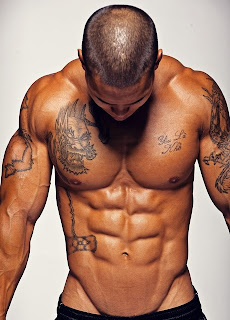 Featured Model: Virginia's own- Pham "Keepittite04"
Featured Model: Virginia's own- Pham "Keepittite04"
